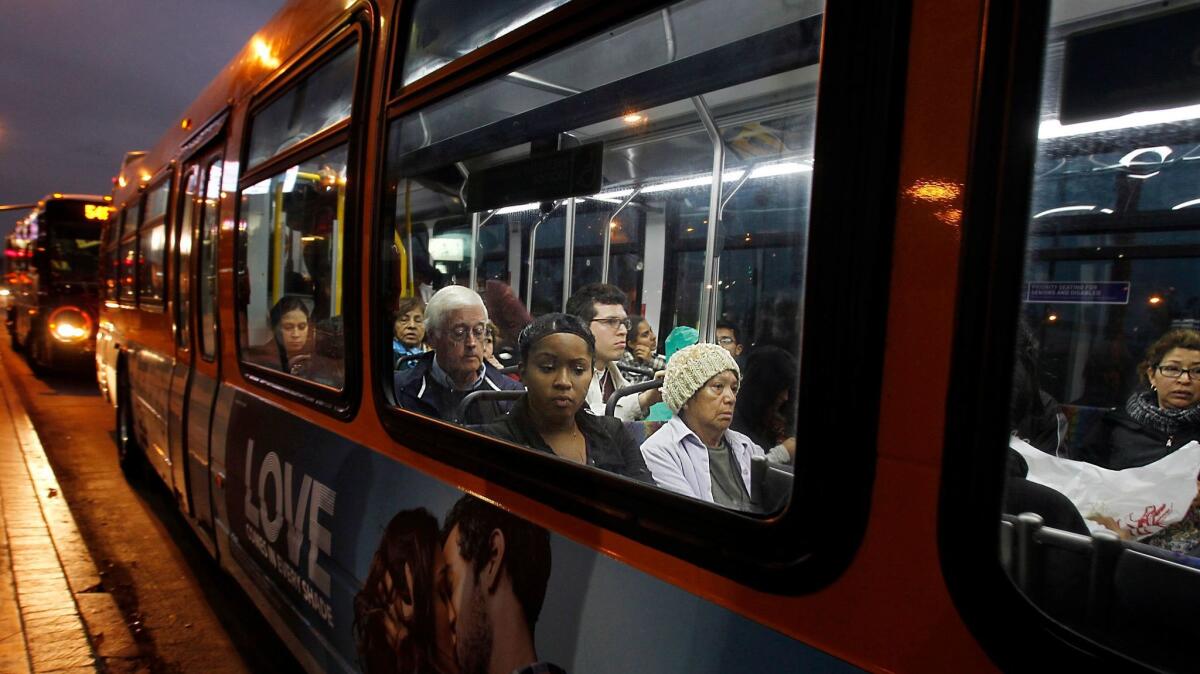Next stop for L.A. Metro: A committee focusing on what it’s like to be a rider

The Metropolitan Transportation Authority has seven committees of elected officials that debate issues as high-profile as rail construction budgets, and as obscure as the amount of water needed to wash 2,248 buses.
What doesn’t exist is a panel that focuses on what it’s like to take transit in Los Angeles County.
That will change this summer, with a new directive from Los Angeles Mayor Eric Garcetti, who is also a Metro director. During his State of the City address Thursday, Garcetti announced the committee, saying taking Metro “shouldn’t be a burden — it should be a convenience.”
“Positively or negatively, every single thing Metro does affects the passenger experience,” said Los Angeles City Councilman and Metro director Mike Bonin, who will run the group. “But it’s not often the primary prism through which a decision is made.”
Garcetti will begin his second term as Metro chair in July. The committee will start meeting after that. Here’s what they may discuss:
Spending an influx of cash
Later this year, Metro will start receiving revenue from Measure M, a sales tax increase for transportation that county voters approved last year. The tax is expected to generate $860 million in 2018, and more than $120 billion over its first four decades.
More than half of that revenue is already earmarked for highway projects and new bus and rail lines that will dramatically expand the size of the region’s transit network.
An additional 27% of the revenue — or $232 million, in 2018 — will go toward transit service, which could influence the number of buses and trains, and how often they run. An additional 2% will be spent on improvements for pedestrians and cyclists.
The committee could weigh in to make sure sure that county voters’ multibillion-dollar investment is as user-friendly as possible, Bonin said.
Improving Metro for current riders
More than three-quarters of Metro riders do not have access to a car. A key goal of the committee will be making transit service cleaner, safer and more reliable for those transit-dependent passengers.
Service complaints are one reason Metro ridership has fallen in recent years.
In a Metro survey of more than 2,000 former passengers, more than six in 10 respondents said they stopped taking transit because it was slow, infrequent, unreliable or difficult to access.
Twenty-nine percent stopped riding because they felt unsafe or uncomfortable.
The committee will also focus on making transit feel more comfortable, including nudging cities to add more bus shelters (or upgrade the ones they already have) and to improve sidewalks and bike lanes near stations, Bonin said.
Attracting new customers
When it comes to commuting, driving still dominates Los Angeles County. More than four in five residents get to work in the car, while 7% take a bus or train, according to census data.
Metro chief executive Phil Washington has said he wants to triple the rate of transit riders. That ambitious goal will require attracting and retaining new customers at a much faster rate than the population grows.
Bonin said the committee will explore ways to boost ridership, noting that “there’s still a lot that we don’t know about why people with the option of using transit don’t choose transit.”
Reaching riders in new ways
“I want it to be very much about feedback, and input,” Bonin said. “I don’t want that to mean people have to come down to MTA headquarters. I want to get creative about how we hear from people.”
One idea, he said, would be to hold some meetings at rush hour at a transit station.
That strategy could address one common criticism of Metro’s public process: Monthly meetings start at 9 a.m., and are always downtown, meaning many working people can’t attend.
What do you think?
If you’re a Metro rider, what improvements do you want to see during your commute?
If you don’t take transit, why not? What would make you change your mind?
Explain in the comments section, or reach out to transportation reporter Laura Nelson on Twitter or via email.
For more transportation news, follow @laura_nelson on Twitter.
ALSO
Metro is eliminating free parking at the San Fernando Valley’s two Red Line stations
The number of pedestrians, cyclists and drivers killed in L.A. traffic rose sharply in 2016
L.A. might start citing motorists again for parking on city parkways
More to Read
Sign up for Essential California
The most important California stories and recommendations in your inbox every morning.
You may occasionally receive promotional content from the Los Angeles Times.











